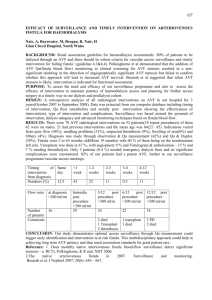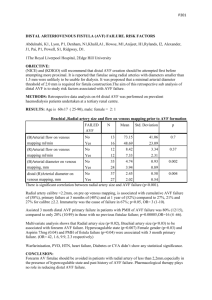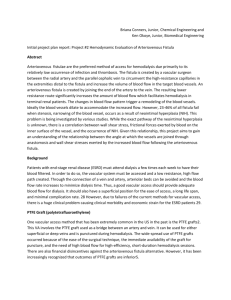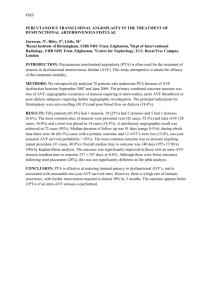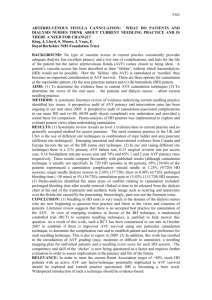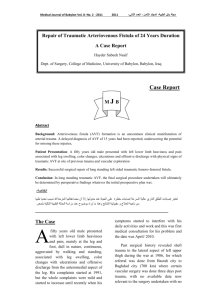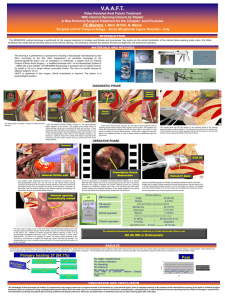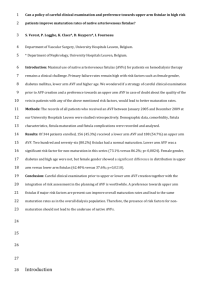SVS Clinical Research Priorities Hemodialysis Access
advertisement
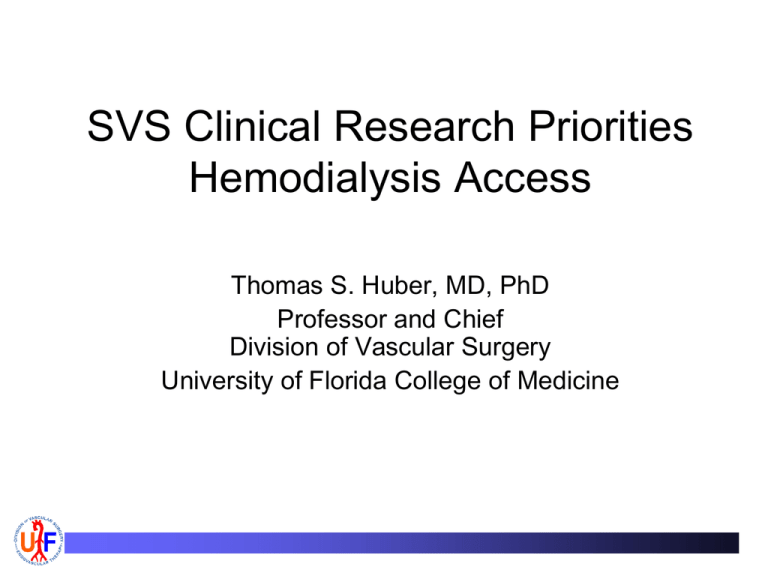
SVS Clinical Research Priorities Hemodialysis Access Thomas S. Huber, MD, PhD Professor and Chief Division of Vascular Surgery University of Florida College of Medicine Patient Counts by Treatment for ESRD USRDS 2008 ADR Prevalent Counts by Modality 65% 30% 5% USRDS 2008 ADR 5-year Mortality by Incident Access USRDS 2008 ADR Admission and LOS by Modality USRDS 2008 ADR Catheter Events and Complications USRDS 2008 ADR Fistula Events and Complications USRDS 2008 ADR Medicare Patients and Cost - 2006 USRDS 2008 ADR Medicare Expenditure – ESRD pt/yr $77K $72K $53K USRDS 2008 ADR Kidney Disease Outcomes Quality Initiative (KDOQI) – Access • NKF guidelines and practice recommendations. • Access guidelines – 1997, 2000, 2006. • Evidence-based approach. – Literature review. – Multidisciplinary work group. • THE GUIDELINES for access care. KDOQI – Overall Goals • Increase use of AV fistula (autogenous). • Detect access dysfunction before thrombosis. 2006 - AVF > 65%, catheters < 10%. KDOQI – Guidelines • • • • Patient preparation for permanent access. Selection and placement of access. Cannulation and accession. Access dysfunction. KDOQI – Guidelines • • • • Treatment of AV fistula complications. Treatment of AV graft complications. Treatment of catheter complications. Clinical outcome goals. SVS Clinical Practice Guidelines • Multidisciplinary group to optimize AV fistula. • Systematic review of evidence (external). – Timing of access referral. – Type of access. – Effectiveness of surveillance. SVS Clinical Practice Guidelines • • • • Timing of referral to access surgeon. Strategies to optimize AV fistula. First choice of access – forearm AV fistula. Choice of access after forearm AV fistula. SVS Clinical Practice Guidelines • Role of monitoring and surveillance. • Conversion of AV graft to AV fistula. • Management of non-functional access. Fistula First Breakthrough Initiative (FFBI) • CMS multi-year initiative to increase AV fistula rates (2003 – 2006). • Multidisciplinary approach - ESRD networks. • KDOQI AV fistula goals – Initial – 50% incidence, 40% prevalence. – Updated – 66% prevalence by 2009. Mission of FFBI • Maximize AVF in all suitable patients. • Minimize dialysis catheter use. • Avoid all types of access complications. *Implemented through “Change Concepts” FFBI AVF Total CVC Total CVC Limitations - Guidelines/Initiatives • Quality of the underlying evidence. • Outcomes may not be achievable. • Potential unintended consequences of emphasis on AV fistula. – Increased catheter use. – Increased AV fistula failure. *New emphasis on “functional” access. Randomized Trials and Meta-analyses • Preoperative strategies. – Ultrasound vein survey (benefit). – MR vs contrast venogram (comparable). • Intraoperative strategies. – Anticoagulation (no benefit). – Anesthesia –stellate block (benefit). – Staples vs suture (likely comparable). Randomized Trials and Meta-analyses • Selection of access type. – – – – – – – AVF vs prosthetic (AVF better). Role of radiocephalic (high failure). Radiocephalic vs forearm prosthetic. Brachiobasilic vs prosthetic (BB better). Brachiobasilic vs brachiocephalic (comparable). Elderly patients (proximal access). One vs two stage brachiobasilic (two stage better). Randomized Trials and Meta-analyses • Choice of prosthetic/biologic graft. – – – – – Biologic vs PTFE (likely comparable). PTFE vs PTFE (comparable). Cuffed vs non-cuffed PTFE (cuff better). PTFE vs TTFE (comparable). Taper vs non taper PTFE (likely comparable). Randomized Trials and Meta-analyses • Strategies to increase patency/decrease neointimal hyperplasia. – Medical. • Antiplatelet agents (no benefit). • Fish oil (no benefit). • Multiple others (unpublished or in progress). – Topical. • Paclitaxel (unpublished or in progress). – Radiation (no benefit). Randomized Trials and Meta-analyses • Surveillance/remediation (potential benefit). – – – – Ultrasound. Flow. Venous pressures. Pre-emptive angioplasty. Randomized Trials and Meta-analyses • Management of complications. – Access thrombosis. • Open vs endovascular (open likely better). • Mechanical vs chemical (comparable). – Venous outflow stenosis. • • • • • Cutting balloons (no benefit). Stents vs angioplasty (no benefit). Covered stent vs angioplasty (covered better). Covered stent vs non-covered (covered better). Heparin-coated balloons (no benefit). Limitations – RCT/Meta-analysis • Device/medication development trials. • Predominantly industry funding source. • Experimental design. – Small sample size. – Single center. Dialysis Access Consortium (DAC) • • • • NIDDK/NIH Consortium started in 2000. Develop access clinical trials. Role of pharmacologic agents. Background of national AVF initiatives. Dember JAMA 2008;299:2164 AVF/Clopidogrel - Hypothesis • Clopidogrel will reduce the occurrence of early AVF thrombosis and increase the proportion of new AVF that can be used for hemodialysis. *Clopidogrel did not facilitate AVF maturation – 62% failure, no difference in adverse events including bleeding. Dixon NEJM 2009;360:2191. AVG/DP/ASA - Hypothesis • DP/ASA can prevent stenosis and prolong survival of AVGs. *no difference in cumulative patency, death, adverse outcome. Median cumulative patency rate 22.5 mos Identification of Factors Associated with Failure of Arteriovenous Fistulas to Mature in Hemodialysis Patients (U01) Prospective multi-center observational cohort study investigating clinical factors predictive of and/or associated with failure of newly placed AVF to mature Hemodialysis Fistula Maturation (HFM) Study Objectives • To identify predictors of AVF maturation. • To evaluate mechanisms of AVF maturation. Domains - anatomy, biology , patient-specific attributes, process of care 38 HFM Study Design • Prospective cohort study of 600 patients undergoing construction of AVF. • Participating centers – Clinical sites (Boston, Cincinnati, Utah, Florida, Washington, Texas-SW. – Cores (Histology, Ultrasound, Physiology). – Data coordinating (Cleveland Clinic). 39 HFM Outcome Measures • Primary - unassisted clinical maturation – Use of the AVF with two needles for 75% of dialysis sessions within a 4-week period • Secondary – other maturation endpoints HFM Unique Features • • • • Vascular physiological testing. Attributes of clinical care. Serial ultrasound measurements. Stored blood and tissue samples. Challenges/Specific Questions • • • • • AV fistula vs AV graft (specific scenarios). Impact of comorbidities on access choice. Access choice after failed forearm access. Two stage vs one stage brachiobasilic. Impact of graft modification on patency. Challenges/Specific Questions • Role of surveillance and remediation. • Management of access complications. – – – – Central vein stenoses. Access-related hand ischemia Venous outflow stenosis. Thrombosed accesses. Challenges/Specific Questions • • • • Algorithm for “complex” access. Impact of access on quality of life. Development of catheter-free algorithms. Optimal process of care Low quality evidence from inconsistent studies with limited protection against bias shows that autogenous access for chronic hemodialysis is superior to prosthetic access. J Vasc Surg 2008;48:34S. Very low quality evidence yielding imprecise results suggests a potentially beneficial effect of AV access surveillance followed by interventions to restore patency. J Vasc Surg 2008;48:48S. Proposed Research Emphasis • Develop a patient-centric, cost-effective algorithm for hemodialysis access. – – – – Initial/subsequent access. Strategies to facilitate AV fistula maturation. Surveillance and remediation. Management of complications. Feasibility of Hemodialysis Access Trial • Significant problem with large patient population. • Low quality evidence with multiple questions. • National funding agency receptive. – Recognize magnitude of problem. – Commitment to clinical problem. – Ongoing discussion about next trial. – Potential for surgeon leadership. *Key to identify “the” most compelling question. Summary • Maintaining hemodialysis access is a tremendous public health problem in terms of the number of affected lives, associated morbidity/mortality and overall societal cost. • The national guidelines and initiatives have defined access care although the supporting evidence is limited. Summary • There are numerous outstanding access-related challenges. • The national funding climate appears receptive for an access-related trial. Conclusion • The Society of Vascular Surgery should focus on end stage renal disease and develop a patient-centric, cost-effective algorithm for hemodialysis access.
